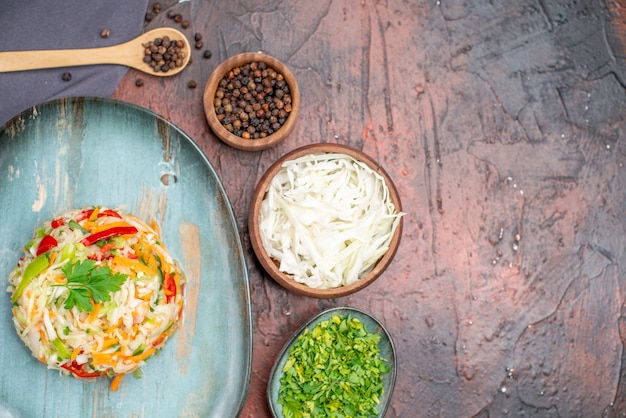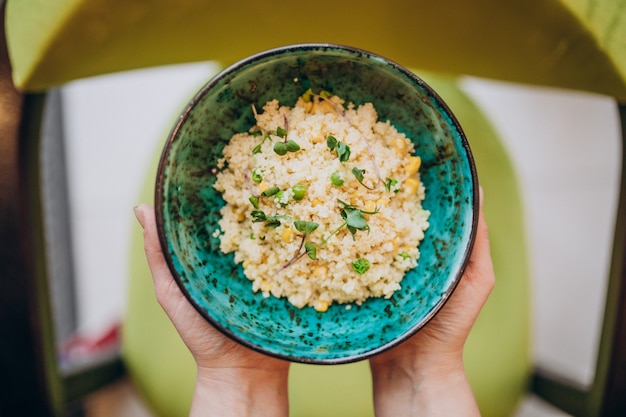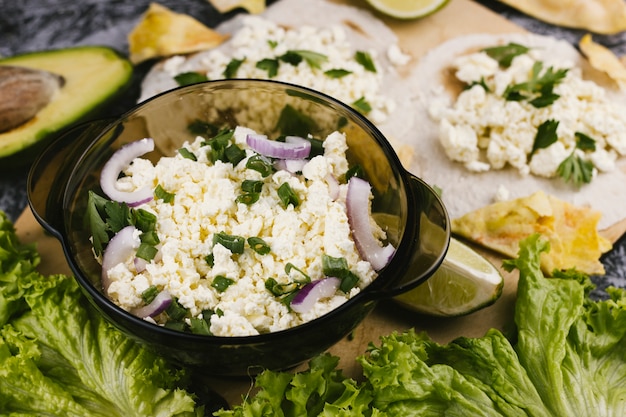You’ve heard the buzz about cauliflower rice, haven’t you? It’s everywhere these days, and for good reason. It’s a brilliant, low-carb alternative to traditional rice, bursting with nutrients and surprisingly versatile. But let’s be honest, the first time I attempted making it, I was a bit dubious. The texture was… well, not exactly what I expected. But like most things in life, practice makes perfect, and after a few experiments, I finally cracked the code to cauliflower rice perfection. And trust me, it's worth the effort.
In this ultimate guide, we’ll dive deep into everything you need to know about cauliflower rice: from choosing the perfect florets to mastering the cooking techniques, plus some delicious recipe ideas to inspire you. So grab a knife, your favourite chopping board, and get ready to embark on a culinary adventure with me!
(Part 1) Choosing the Right Cauliflower: The Foundation of Flavor

First things first, you'll need to pick the right cauliflower. This might seem obvious, but it's crucial. You want a cauliflower that's nice and firm, with no signs of wilting or browning. And here's a tip: go for a cauliflower that's slightly smaller, as these tend to have a better ratio of florets to stem.
Tips for Picking the Perfect Cauliflower:
- Check the colour: Look for a bright white cauliflower with no discolouration. A pale or yellowish hue suggests the cauliflower may be old or has been exposed to too much light.
- Feel the florets: The florets should be firm and tightly packed. Avoid any that are loose or mushy, as this indicates they may be past their prime.
- Inspect the stem: The stem should be firm and free of any blemishes. A soft or discoloured stem can indicate that the cauliflower is not fresh.
(Part 2) The Grate Debate: How to Make Cauliflower Rice

Now, here's where things get interesting. There are two main methods for making cauliflower rice: the good old-fashioned grating method and the trusty food processor. Personally, I've tried both, and each has its own pros and cons.
Grating Cauliflower: The Traditional Way
This is the way my Mum taught me, and it's a classic for a reason. It's simple, requiring only a good grater and some elbow grease. Just chop the cauliflower into bite-sized pieces and grate away!
Advantages of Grating:
- No fancy equipment: All you need is a grater, something most kitchens have. This makes it accessible and budget-friendly.
- Control over texture: You can choose how fine or coarse you want your cauliflower rice. This allows for customization based on your preference, whether you like a finer, rice-like consistency or a chunkier texture.
Disadvantages of Grating:
- Time-consuming: It can take a while to grate a whole cauliflower, especially if you're doing it by hand. This can be a bit tedious, especially if you're short on time.
- Arm workout: Be prepared to flex those biceps! Grating cauliflower can be a bit of a workout, so be sure to have a comfortable surface and a good grip.
Food Processor: Quick and Easy
For those who want a quicker, less strenuous method, the food processor is your best friend. Simply chop the cauliflower into chunks and pulse it in the processor until it resembles rice.
Advantages of Food Processor:
- Fast and efficient: You can whip up cauliflower rice in minutes, making it a perfect option for busy weeknights.
- Consistent texture: You'll get a more even texture than with grating, resulting in a more uniform cauliflower rice.
Disadvantages of Food Processor:
- May over-process: It's easy to over-process and end up with a mushy mess. Keep an eye on the cauliflower as you pulse to ensure it doesn't become too fine.
- Requires cleaning: An extra step, but it's worth it for the convenience. This is a tradeoff, but the time saved on grating may be worth the extra cleaning time.
(Part 3) Mastering the Cooking Techniques: Unlocking Flavor and Texture

Alright, you've got your cauliflower prepped. Now it's time to get cooking! But how, you ask? Well, I've experimented with various methods, and here are my top recommendations.
Method 1: The Microwave Magic: Quick and Easy
This is my go-to method for a quick and easy weeknight meal. Simply place the cauliflower rice in a microwave-safe bowl, add a splash of water, and microwave for a few minutes until tender. This method is perfect for when you need a fast and simple solution.
Advantages of Microwaving:
- Speed: It's the fastest way to cook cauliflower rice, especially when time is tight. It's perfect for busy evenings when you want to get dinner on the table quickly.
- Minimal cleanup: No pots or pans to wash, making it even more convenient. This means fewer dishes to do and more time to enjoy your meal.
Disadvantages of Microwaving:
- May not be as flavorful: It can sometimes lack the depth of flavour you get from other methods. The lack of browning or caramelization can sometimes result in a less flavorful dish.
Method 2: The Pan-Seared Sensation: Adding Depth and Crunch
For a bit more flavour and texture, try pan-searing your cauliflower rice. Heat some oil in a pan, add the cauliflower rice, and stir-fry until golden brown and slightly crispy. This method brings out a wonderful depth of flavor and a delicious crunch.
Advantages of Pan-Searing:
- Flavorful: The browning adds a delicious depth of flavour. The Maillard reaction, which occurs during browning, produces complex and savory notes.
- crispy texture: A delightful contrast to the soft inside. The crispy exterior adds a satisfying textural element to your dish.
Disadvantages of Pan-Searing:
- May stick to the pan: Keep a close eye on it, as it can easily burn. Use a non-stick pan or add a bit more oil to prevent sticking.
Method 3: The Roasting Delight: Crispy, Caramelized Goodness
For a truly satisfying meal, roast your cauliflower rice in the oven. Toss it with olive oil, salt, pepper, and your favourite spices, and bake until crispy and golden brown. Roasting brings out a delightful caramelized flavor and a crispy texture that makes cauliflower rice irresistible.
Advantages of Roasting:
- Naturally delicious: It develops a lovely caramelized flavour. The slow roasting process allows the sugars in the cauliflower to caramelize, creating a sweet and nutty flavor.
- Versatile: It works well with a variety of toppings and flavours. You can customize the roasting process by adding different spices and herbs to create a wide range of flavor profiles.
Disadvantages of Roasting:
- Takes longer: It's not as quick as other methods. This method requires a bit more time, so it's best for when you have a little more time to cook.
(Part 4) Adding Flavour to Your Cauliflower Rice: A Culinary Symphony
Now, let's talk flavour! Cauliflower rice itself doesn't have much flavour, but it's a blank canvas for your culinary creativity. Here are some tips for adding a punch of flavour to your cauliflower rice:
Spice It Up: A Touch of Heat
I love adding a kick of spice to my cauliflower rice. A pinch of chilli flakes, a sprinkle of cumin, or a dollop of sriracha can transform a simple dish into a flavour explosion. Spice is a great way to add depth and complexity to cauliflower rice, from subtle hints to fiery heat.
Get Saucy: Elevating Flavor with Sauce
Sauces are your friend! From a simple soy sauce glaze to a creamy pesto drizzle, there's a sauce out there for every taste. And don't forget about the classic curries! Cauliflower rice is an excellent substitute for traditional rice in curries. Adding a sauce can instantly elevate the flavour and create a more complete and satisfying dish.
Embrace Herbs and Spices: Aromatic Delights
Fresh herbs and spices are a must-have for any cauliflower rice dish. Think rosemary, thyme, garlic, ginger, or even a dash of lemon zest. These ingredients can add a burst of fresh, aromatic flavour to your cauliflower rice.
Go for a Tangy Twist: Balancing Flavor
A touch of acidity can really elevate the flavour of cauliflower rice. Try adding a squeeze of lemon juice, a splash of lime, or even a few drops of balsamic vinegar. A touch of acidity can help to balance out the sweetness of the cauliflower and create a more complex and refreshing flavour.
(Part 5) cauliflower rice recipes to Inspire You: A culinary journey
I know what you're thinking: "This all sounds great, but what can I actually make with cauliflower rice?" Fear not, my friend, because I've got you covered. Here are a few of my favourite cauliflower rice recipes to get you started. These recipes are simple, flavorful, and perfect for any occasion.
Recipe 1: Spicy Cauliflower Rice Stir-Fry: A Weeknight Delight
This is my go-to weeknight dinner. It's quick, easy, and packed with flavour. Here's what you'll need:
Ingredients:
- 1 head of cauliflower, riced
- 1 tablespoon olive oil
- 1 onion, chopped
- 1 bell pepper, chopped
- 2 cloves garlic, minced
- 1 cup mixed vegetables (such as broccoli, carrots, and snap peas)
- 1/2 cup chicken broth
- 1 tablespoon soy sauce
- 1 teaspoon sesame oil
- 1/2 teaspoon chilli flakes (optional)
- Salt and pepper to taste
Instructions:
- Heat the olive oil in a large skillet or wok over medium heat.
- Add the onion, bell pepper, and garlic and cook for 5 minutes, or until softened.
- Stir in the cauliflower rice, mixed vegetables, chicken broth, soy sauce, sesame oil, and chilli flakes (if using).
- Bring to a boil, then reduce heat and simmer for 5 minutes, or until the cauliflower rice is tender and the vegetables are cooked through.
- Season with salt and pepper to taste.
- Serve immediately.
Recipe 2: Creamy Pesto Cauliflower Rice Bowl: A Flavorful and Healthy Option
This bowl is a flavour explosion with a creamy pesto sauce and crunchy veggies. It's both satisfying and healthy. This recipe is a great way to enjoy a light and refreshing meal.
Ingredients:
- 1 head of cauliflower, riced
- 1/2 cup cooked quinoa
- 1/2 cup cherry tomatoes, halved
- 1/4 cup chopped red onion
- 1/4 cup chopped fresh basil
- 1/4 cup grated Parmesan cheese
- 1/4 cup pesto sauce
- Olive oil
- Salt and pepper to taste
Instructions:
- Roast the cauliflower rice in the oven until golden brown and slightly crispy.
- In a bowl, combine the cauliflower rice, quinoa, cherry tomatoes, red onion, and basil.
- Drizzle with olive oil and pesto sauce.
- Top with Parmesan cheese.
- Season with salt and pepper to taste.
Recipe 3: Coconut Curry Cauliflower Rice: A Quick and Easy Curry
This is a quick and easy curry recipe that's perfect for a busy weeknight. The coconut milk adds a creamy richness, and the curry powder packs a punch of flavour. This recipe is a great way to enjoy a comforting and flavorful meal.
Ingredients:
- 1 head of cauliflower, riced
- 1 tablespoon olive oil
- 1 onion, chopped
- 2 cloves garlic, minced
- 1 tablespoon curry powder
- 1 (14-ounce) can full-fat coconut milk
- 1/2 cup vegetable broth
- Salt and pepper to taste
Instructions:
- Heat the olive oil in a large saucepan or dutch oven over medium heat.
- Add the onion and garlic and cook for 5 minutes, or until softened.
- Stir in the curry powder and cook for 1 minute, until fragrant.
- Add the cauliflower rice, coconut milk, and vegetable broth.
- Bring to a boil, then reduce heat and simmer for 10 minutes, or until the cauliflower rice is tender and the sauce has thickened.
- Season with salt and pepper to taste.
- Serve immediately.
(Part 6) Cauliflower Rice vs. Traditional Rice: A Head-to-Head Showdown
Now, let's face it, cauliflower rice is no match for traditional rice in terms of flavour. But it does hold its own in other areas. So, let's have a little showdown, shall we? This comparison will help you understand the differences and decide which option is best for you.
| Cauliflower Rice | Traditional Rice | |
|---|---|---|
| Carb Content | Low carb | High carb |
| Nutrient Profile | Rich in vitamins, minerals, and fibre | Provides some nutrients, but less than cauliflower rice |
| Texture | Slightly grainy and crunchy | Soft and fluffy |
| Taste | Milder flavour, can be enhanced with spices | Distinctive flavour, can be paired with various dishes |
| Versatility | Versatile for stir-fries, curries, bowls, and more | Versatile for various dishes, including rice pilafs, sushi, and desserts |
(Part 7) Cauliflower Rice: Beyond the Basics: Exploring New Horizons
Alright, you've got the basics down. But let's go a little deeper and explore some advanced techniques and ideas. Let's push the boundaries of cauliflower rice and discover new possibilities.
Get Creative with Toppings: Unleashing Your Inner Chef
Don't be afraid to experiment with toppings! Think about adding avocado, nuts, seeds, pickled ginger, sriracha, or even a fried egg. The possibilities are endless! Toppings can add a burst of flavor, texture, and visual appeal to your cauliflower rice dishes.
Try Different Flavour Profiles: Embracing Global Cuisine
Instead of sticking to the same old flavours, try experimenting with different cuisines. Think Thai green curry, Mexican rice bowls, or even Japanese-inspired dishes. This is a great way to broaden your culinary horizons and create exciting and flavorful dishes.
Cauliflower Rice: A Versatile side dish: Enhancing Your Meals
Don't forget that cauliflower rice can be a brilliant side dish. It goes perfectly with grilled meats, fish, or vegetables. And it's a great way to add a bit of flavour and texture to your meals. This is a fantastic way to add a nutritious and flavorful element to your meals.
Cauliflower Rice: A Healthy Snack: Satisfying Your Cravings
Yes, you read that right! Cauliflower rice can be a healthy and satisfying snack. Toss it with some olive oil, salt, pepper, and your favourite spices, and roast it in the oven until crispy. It's a delicious and crunchy snack that's perfect for munching on between meals. Cauliflower rice is a great option when you're looking for a healthy and satisfying snack that will keep you full and energized.
(Part 8) FAQs About Cauliflower Rice: Addressing Your Questions
Let's address some common questions about cauliflower rice. This section will clear up any doubts and provide answers to frequently asked questions.
1. How long does cauliflower rice last in the fridge?
Cauliflower rice can last in the fridge for up to 3-4 days. Store it in an airtight container to prevent it from drying out and absorbing odors from other foods in your refrigerator.
2. Can I freeze cauliflower rice?
Yes, you can freeze cauliflower rice for up to 3 months. It's best to freeze it raw, as freezing it cooked can make it mushy. To freeze, spread it out on a baking sheet and freeze until solid. Then transfer it to a freezer-safe bag. This method helps to preserve the texture and flavor of the cauliflower rice.
3. Is cauliflower rice good for you?
Absolutely! Cauliflower rice is a good source of vitamins, minerals, and fiber. It's also low in carbohydrates, making it a great choice for those following a low-carb diet. It's also a good source of Vitamin C, Vitamin K, and potassium. Cauliflower rice is a nutritious and versatile choice for those looking to incorporate more vegetables into their diet.
4. Can I use a blender to make cauliflower rice?
You can use a blender, but it's not the best option. It can over-process the cauliflower and create a mushy texture. A food processor or grater is a better choice. While a blender can be used, it's not ideal for creating the desired texture for cauliflower rice.
5. What are some good substitutes for cauliflower rice?
If you're not a fan of cauliflower rice or don't have any on hand, you can try other low-carb alternatives, such as broccoli rice, zucchini noodles, or even shredded Brussels sprouts. These options offer similar textures and nutritional benefits to cauliflower rice.
And there you have it, folks! Your complete guide to cauliflower rice. Now go forth and experiment! You'll be amazed at how versatile and delicious this little veggie can be.
Everyone is watching

Corn on the Cob: The Ultimate Guide to Perfectly Cooked Ears
Healthy MealsAh, corn on the cob. Just the name evokes images of sunny days, barbecues, and that sweet, juicy flavour that ...

Perfect Pork Roast Oven Cooking Time: A Guide to Delicious Results
Healthy MealsThere's something truly satisfying about a perfectly roasted pork. The aroma alone is enough to make your mout...

Scallops: The Ultimate Guide to Perfect Cooking
Healthy MealsAh, scallops. Those delicate, sweet, and utterly delicious morsels of the sea. They hold a special place in my...

Ham Cooking Time: How Long to Bake, Smoke, or Boil a Delicious Ham
Healthy MealsAh, ham. It's a classic, isn't it? A real crowd-pleaser, especially around holidays. And when done right, it'...

Spaghetti Squash: The Ultimate Guide to Cooking and Serving
Healthy MealsRemember that time you saw spaghetti squash at the supermarket, looking all bumpy and strange, and thought, "W...
